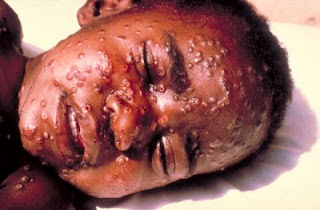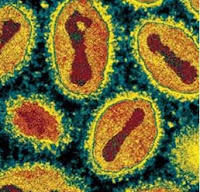Below is an article I originally wrote for the school paper science/tech page and beefed up for this blog. It's a bit awkward, but I feel like I did a decent job. Another random post, and I don't care. Huzzah!

Poxviruses are the biggest and most complex animal viruses. The human poxvirus, smallpox, was one of the major causes of death in many civilizations for a long time. Smallpox killed about 500 million people in the 20th century—far more than the deaths caused by wars, the 1918 flu pandemic, and AIDS combined. Famous victims include Ramses V, Mozart, Beethoven, George Washington, Andrew Jackson, Abraham Lincoln, Joseph Stalin, Mary Queen of Scots, Mary II of England, Louis XV of France, and Peter II of Russia.
The ordinary form of smallpox has a 30% mortality; however, two other types, the flat and hemorrhagic manifestations, are almost always fatal. The disease is characterized by rounded vesicles that are usually dimpled, and found mostly around the head and extremities. The bumps have been described as feeling like BB gun pellets embedded in the skin. Many survivors are badly scarred or even blinded.
PreventionThere have been attempts to prevent or lessen the impact of a smallpox infection via inoculation for centuries. All sorts of methods have been used, from inhaling ground up scabs to introducing the virus through cuts in the skin. Though death from these sorts of infection was still possible, the mortality was far lower and thus worth the risk.

In 1796, Edward Jenner began experimenting with vaccination by purposely infecting an eight-year-old boy, James Phipps, with cowpox, a bovine virus related to smallpox. It was fairly well-known in rural areas that milkmaids rarely contracted smallpox, and Jenner wanted to investigate this. After contracting cowpox, little Phipps was mildly ill (a low fever and some pox for about a week), but showed no sign of infection after being exposed to smallpox later on. It turns out that cowpox confers immunity to smallpox. To put it simply, the body learns how to handle smallpox infection by being exposed to its mild-mannered cousin. Nowadays this experiment by the "father of immunology" would be considered unethical, but at the time his discovery was revolutionary. Jenner tested several other individuals, published his work, and led an effort to develop a vaccine for smallpox made from the pus of cowpox bumps.
Thanks to the work of Jenner and other pioneers in the field, a vaccine was developed. At first, vaccines were often contaminated and sometimes caused health problems, but once again, the benefits far outweighed the rare serious side effects. During the 19th century, many countries declared smallpox vaccination mandatory. Once mass vaccination became commonplace, the rates of smallpox infection in developed areas plummeted.
EradicationIn 1967, the World Health Organization (WHO) made the decision to attempt worldwide eradication of smallpox. The disease is an excellent candidate for eradication for several reasons. First, it is exclusive to humans, so there is no animal carrier. There is a very effective, inexpensive vaccine against it. People are not carriers for the disease once they get over it. And finally, cases of smallpox are easily identifiable, thanks to the distinctive bumps and rash pattern.

At this time, vaccination was widespread in developed countries, so WHO efforts were concentrated in third-world countries. Vaccination ended in the United States in 1972 because of the incredibly low incidence and the possibility of severe side effects.
Rather than try to vaccinate all members of the global population, the WHO decided to address individual cases. Cards with photos of infected individuals and a basic clinical description of the disease were widely distributed. When a case of smallpox was identified, the WHO was contacted. They then put the infected individual in isolation and vaccinated all people in the general area, a process called “ring vaccination.” Once cases became less common, cash rewards were offered for reporting sick individuals. The last natural case occurred in Somalia in 1977. The world was officially declared smallpox-free in 1980.
Though smallpox is no longer found in the wild, it does exist in two laboratories, the CDC in Atlanta and the Vector Institute in Koltsovo, Russia. The virus is important to keep in the laboratory. Even though it is not necessary for vaccination against the disease, it is useful for research in development of antivirals and other vaccines. The decision to maintain the virus in the laboratory has been a controversial one. There is the distinct risk of it somehow making its way out of the laboratory, since smallpox is an excellent biological weapon.
Smallpox as a Biological WeaponA good biological weapon doesn’t just cause suffering—it makes a society fall apart. Smallpox kills or permanently scars most who are infected. It is highly contagious, and because we no longer vaccinate against it, most people have no immunity. In the event of a widespread smallpox epidemic without emergency vaccination, people would not go to work, a general fear would pervade communities, children could not go to school, and even the government might begin to shut down.

Smallpox as a biological weapon would not be a new phenomenon. For instance, Cortez inadvertently wiped out a good portion of the Aztec population because of one infected member of his expedition. The British in the French and Indian war gave Native Americans blankets that had been in contact with people who had smallpox, though it is unclear how effective it was. There is also some evidence that smallpox was used in the American Revolutionary War.
It is frightening to think how a disease like smallpox could disable our society. Fortunately, our country is not entirely susceptible to smallpox as a bioweapon, since enough vaccine has been stored to
protect the entire population in the event of an attack.
RelevanceSo far, smallpox is the only disease to be fully eradicated. There have been other eradication programs that were abandoned (hookworm, malaria, yaws, and yellow fever) and a few others that are ongoing (poliomyelitis and dracunculiasis). Other potential candidates are measles, mumps, rubella, tapeworm, and filariasis.
People who are against the idea of vaccination in general often do not realize that vaccines against smallpox, polio, influenza, measles, and rabies have saved millions of lives. Yes, there are occasional side effects with all of these vaccines, but the benefits acquired by disease prevention greatly outweigh the negative consequences of mass vaccination.
Inhabitants of developed countries tend to forget that less developed or more densely populated countries have huge problems with all of these diseases. Diseases that seem rare and basically harmless can be huge threats in third world countries, where adequate nutrition and proper medical care are not always available. For instance, measles, a childhood disease that hasn't been common in a long time, has a 28% mortality rate in third-world countries. TWENTY-EIGHT PERCENT. In order for a disease to be completely eradicated, there has to be immunity on a global scale. The complete eradication of smallpox, which for millennia was a significant problem, is an amazing feat for mankind. It has shown that with a strong, organized effort, much human suffering and death can be avoided.
 Aka, deoxyribonucleic acid (DNA) is the genetic material! This journal article, published in 1952 by Alfred Hershey and Martha Chase, is a landmark discovery in molecular biology. I won't go into the gritty details, but I will offer some background and the basic gist of the experiment. (FYI, it's not the anniversary of its publication or anything--I'm just really excited that the .pdf is available online for free :-) )
Aka, deoxyribonucleic acid (DNA) is the genetic material! This journal article, published in 1952 by Alfred Hershey and Martha Chase, is a landmark discovery in molecular biology. I won't go into the gritty details, but I will offer some background and the basic gist of the experiment. (FYI, it's not the anniversary of its publication or anything--I'm just really excited that the .pdf is available online for free :-) ) Hershey and Chase wanted to see what a virus used to infect bacteria (the "infectious material"). They labeled the proteins in one batch of virus with radioactive sulfur, and the DNA in another batch with radioactive phosphorus. They let the viruses hang out with the bacteria for a little while, then tested to see which batch of bacteria had labeled material. They discovered that the only bacteria with radioactive material were the ones that had been infected using viruses labeled with phosphorus--basically, DNA, not protein, was being used to pass on genetic material from virus to bacterium. Here is a diagram that does a way better job illustrating what I'm trying to explain:
Hershey and Chase wanted to see what a virus used to infect bacteria (the "infectious material"). They labeled the proteins in one batch of virus with radioactive sulfur, and the DNA in another batch with radioactive phosphorus. They let the viruses hang out with the bacteria for a little while, then tested to see which batch of bacteria had labeled material. They discovered that the only bacteria with radioactive material were the ones that had been infected using viruses labeled with phosphorus--basically, DNA, not protein, was being used to pass on genetic material from virus to bacterium. Here is a diagram that does a way better job illustrating what I'm trying to explain:



